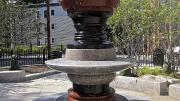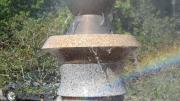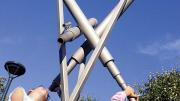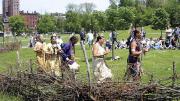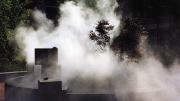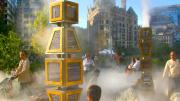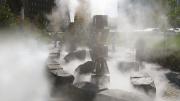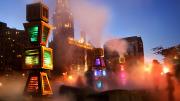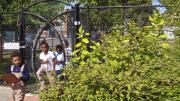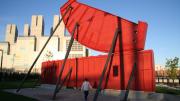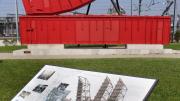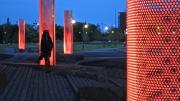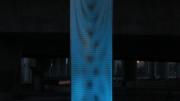Tucked away in a small stretch of grass near MIT’s campus, the art in University Park Common reveals itself slowly to visitors. In one corner stands a slowly rusting spool of wire, a nod to the Simplex Wire Company that once stood on the site. Across the way models of three telescopes represent another past tenant, the Alvan Clark & Sons telescope manufacturer. In a third spot lie scattered bronze castings of the oyster shells dug up when new construction reshaped the neighborhood. These small surprises make up Historical Traces (1998), by Boston-based public artist Ross Miller’77 (www.rossmiller.com). “It’s just little layers,” he says. “Even I forget where they are.”
Miller, a Loeb Fellow at Harvard in 1992-93, has spent more than three decades creating subtle, interactive artworks that help visitors rethink the places they inhabit every day. The job of the public artist, he says, is to bring the “wonderful moments” of surprise a visitor might encounter in nature—a fallen log crossing the path, a streak of light hitting a leaf just right—into the city. Unfortunately, he explains, “The things that happen accidentally when you walk through the city are often ugly and broken.” Artists can change that. After concentrating in visual and environmental studies in college (and taking a year off to study with industrial designer Eva Zeisel), Miller began his project of reintroducing nature’s curves into the rigid grid of the city.
His commissions have returned a “natural variety” to some of Boston’s most prominent places. Often, they build on the history of the sites, helping resurrect the city’s forgotten stories. In the sidewalk near Faneuil Hall, Miller embedded a set of etchings of the city’s colonial-era shoreline (Original Shoreline Mark, 1996), and each year, he leads the construction of a replica of a Native American wooden fishweir (a fence used to catch spawning fish) on Boston Common.
Miller has become increasingly interested in adding art to urban spaces that tourists often miss. Recently, he helped transform what was once little more than a rundown strip of concrete and grass in a quiet Roxbury intersection into the refurbished Alvah Kittredge Park. At one corner stands Carved in Stone (2012), his unusual monument to abolitionist William Lloyd Garrison, once a neighborhood resident. Instead of making a contemplative marble bust, Miller stacked up an undulating 10-foot-tall column of circular granite pedestals—19,000 pounds of stone in shades of gray, black, and red—leading to a metal nozzle that shoots out jets of water and fog at the push of a button.
When he revisits earlier works, Miller likes to ask those he encounters how they learned about the space and what they think of what they’ve found there. At the Roxbury site, he spots a young girl standing off to the side, watching the fine mist that sprays out, wetting the concrete below. Smiling, he asks whether she’s discovered the fountain’s secret: when viewed straight on, it acts as a Rubin’s Vase, creating two mirror-image silhouettes of Garrison’s profile in the negative space surrounding its lower half.
“Hopefully that girl will go and look at that silhouette again, and show a friend of hers. That’s something I would love to see,” Miller says. “I’ve gone to that park and people have shown me that silhouette.” In these small neighborhood parks, he likes to create designs that will reveal themselves slowly to local residents who return time after time. “There’s a value in doing things that can be sort of subtle, and last for a long time—so you might uncover it or see it new,” he says.
At the Garrison monument, the top water nozzle isn’t working. How his art is maintained in different parts of the city has become increasingly important to him—a sign of how government officials or developers treat art in rich, versus poor, neighborhoods. When workers re-poured the concrete pavement at his MIT work, they carefully re-sandblasted a quote from transcendentalist writer Margaret Fuller—touching on the “delight” we find in nature’s “varying arrangements”—into the sidewalk. But the hanging time capsule he placed two decades ago in a glass case in South Boston’s Andrew Square MBTA station has received far less attention. The windows are now so dirty that visitors can barely see inside.
Miller seeks out highly accessible spaces, rather than cloistered private gardens or corporate courtyards. So often, he explains, “public” space is what’s left over between the private spaces of office buildings and condominiums. Usually, public-works departments handle the maintenance, keeping such spots clean, but little else. “The beauty, the joy, the wonder that people deserve in public areas doesn’t happen,” Miller says. But art—inexpensive in the grand scheme of city budgets—can effectively show residents that they matter. “Art ‘turns up the volume’ of the experience of being in a specific place,” he declares, “one that’s different than being in another place.”
